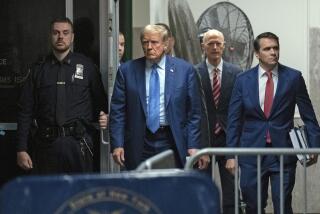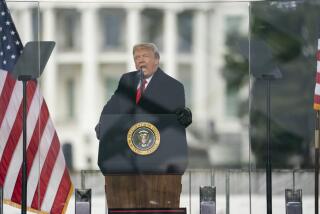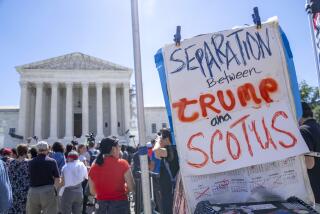Q&A:: Trump scores a partial win for his travel ban. What comes next?

The Supreme Court revived parts of Trump’s travel ban. (June 27, 2017)
- Share via
Reporting from Washington — What’s next after the Supreme Court cleared the way for parts of President Trump’s travel ban executive order to begin taking effect? Here are some answers.
Does this put Trump’s travel ban into effect?
Not exactly. The court said only part of the ban could take effect pending the justices’ consideration of it this fall. The ban still would not apply to any foreigners who have a “bona fide relationship” with a person or entity in the U.S., such as a relative, a university or an employer. Because it is believed that many visitors from the six mostly Muslim countries at issue have such a relationship, the effect of the order may be limited. That’s been the position of the attorneys for the plaintiffs.
What happens next?
The State Department, Department of Homeland Security and other agencies said they are reviewing the order to figure out how to respond and begin implementing the partial ban. Beyond a statement celebrating the decision, White House Press Secretary Sean Spicer referred questions about administrative responses to the Justice Department, which would first analyze the justices’ opinion.
Administration officials will be eager to avoid the kind of chaos at airports that occurred when Trump tried to enforce his original, broader ban against visitors from seven countries. But because the new ban applies only to people who do not already have a valid visa, that kind of confusion is not likely.
“The implementation of the executive order will be done professionally, with clear and sufficient public notice, particularly to potentially affected travelers, and in coordination with partners in the travel industry,” the Department of Homeland Security said in a statement Monday.
Supreme Court finds a compromise in reviving Trump’s travel ban »
What about the arguments that Trump’s ban is unconstitutional?
Issues about religious discrimination, presidential power and other constitutional issues were not directly addressed in the court’s decision on Monday. Instead the justices agreed to hear those matters in the fall.
However, they noted that by then the entire case may be moot because the 90-day ban will have expired. And the justices indicated that by the fall, the Trump administration will have had plenty of time to come up with new and permanent vetting procedures to ensure national security.
A unanimous ruling? That sounds like a big victory for the president.
Yes and no. The president overstates the breadth of his victory. The justices took a middle ground, which is probably why all justices agreed; they were unanimous on only part of what they did. The three most conservatives justices, including Trump’s one appointee, Neil M. Gorsuch, wrote a partial dissent. Gorsuch, along with Justices Clarence Thomas and Samuel A. Alito Jr., said they would have preferred to go further and allow Trump’s entire ban to go into effect. That suggests that the other six justices have reservations about allowing the full ban to take effect, and Trump will still have to win over two more justices if and when the full case is debated by the court.
Why hasn’t the Trump administration already completed its review of immigration policies?
The president’s revised executive order, which was intended to take effect on March 16, would have halted travel for 90 days for residents of Iran, Libya, Somalia, Sudan, Syria and Yemen (Iraq was removed from the list), and suspended refugee admissions from any country for 120 days so that the administration could conduct a review of vetting procedures. The 90-day period theoretically would have expired on June 14 (Flag Day and Trump’s birthday). But the temporary restraining order issued by a Hawaii judge barred the administration from “enforcing or implementing” those portions of the executive order, a prohibition that theoretically extended to a review.
The White House issued a memo on June 14 stipulating that, given the injunction halting the order, it would essentially restart the clock on that review process 72 hours after any subsequent court order reinstating the ban.
What that also could mean is that by the time the Supreme Court would ultimately hear arguments about the constitutionality of the order — not until a new term begins in the fall — the administration will have completed its review and potentially ended the temporary travel and refugee bans.
How will it be decided whether someone has a “bona fide” relationship that exempts them from the ban?
The court gave several examples, such as students enrolled in U.S. universities, people with close relatives in the U.S. and workers offered jobs in the country.
But in his dissent, Thomas predicted the decision would cause a “flood of litigation until this case is finally resolved on the merits, as parties and courts struggle to determine what exactly constitutes a ‘bona fide relationship,’ who precisely has a ‘credible claim’ to that relationship, and whether the claimed relationship was formed” simply to avoid the travel ban.
What does this mean for refugees?
Trump’s revised travel ban put a 120-day limit on what had originally been an indefinite suspension of accepting refugees from Syria, and removed contested language intended to help Christian refugees and other religious minorities who face persecution win asylum. It retained language that slowed the entry of asylum seekers dramatically, capping the program at 50,000 refugees for the year, compared with 110,000 allowed under policies of the Obama administration.
As with the rest of the order, the Trump administration has yet to address what the court’s action means for that plan. But plaintiffs in the case, including groups that represent refugees, argue that it will have a minimal effect.
They say people who are granted refugee status are automatically referred by the U.S. government to a nongovernmental organization that provides them with social services and other relocation help. They argue that those connections should count as extensive ties to an existing organization in the United States, as long as the process has already begun.
That could, however, be subject to interpretation by another court. If plaintiffs lose that argument, they could get another bite at the apple by arguing on behalf of refugees who have family ties in the United States. They say tens of thousands of potential refugees meet that criteria.
To read the article in Spanish, click here
For more coverage, follow @mikememoli, @noahbierman and @DavidGSavage on Twitter.
ALSO
Supreme Court finds a compromise in reviving Trump’s travel ban
In his first Supreme Court opinion, Gorsuch shows writing flair, strict interpretation of law
Trump’s travel ban contains a tool that could change how the U.S. conducts foreign policy
Get live updates on our Essential Washington news feed
UPDATES:
2:30 p.m.: This story was updated with new details of the court decision.
This story was published at 12:15 p.m.
More to Read
Get the L.A. Times Politics newsletter
Deeply reported insights into legislation, politics and policy from Sacramento, Washington and beyond. In your inbox three times per week.
You may occasionally receive promotional content from the Los Angeles Times.













